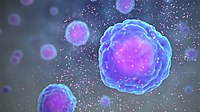
Photo from wikipedia
Introduction Dysregulated immune homeostasis is implicated in atherosclerosis. Monocytes are described as inert innate immune cells that respond to vascular and inflammatory cues to extravasate into the intima then differentiate… Click to show full abstract
Introduction Dysregulated immune homeostasis is implicated in atherosclerosis. Monocytes are described as inert innate immune cells that respond to vascular and inflammatory cues to extravasate into the intima then differentiate into ’active’ macrophage foam cells on encountering lipid, resulting in the formation of fatty streaks in atherosclerotic plaque. Monocytes are however heterogeneous cells with distinct subsets; classical (CD14+CD16-) "inflammatory", non-classical (CD14-CD16+) "patrolling" and intermediate (CD14+CD16+) monocytes. These subsets differ in both morphology and functional responses. Dietary saturated fat (SF) intake is somewhat controversially implicated in cardiovascular disease (CVD) from epidemiological observational and interventional studies, whilst cellular data suggest SF to provide a pro-inflammatory stimulus to leukocytes. Recent dietary and mendelian randomisation studies record a positive correlation between triglyceride rich lipoprotein (TGRL), remnant cholesterol and CVD, renewing interest in diet lipid intake as a CVD risk factor. Little is known however about the cellular nature of this risk and what role if any the innate immune system plays in inflammation and lipid trafficking. I investigated the monocyte subset response to acute dietary lipid intake intake in this context. Methods I conducted a dietary interventional study in 8 healthy adult human volunteers fed a lauric acid-rich SF meal. Monocytes were purified from whole blood into CD16- (classical) and CD16+ (non-classical & intermediate) subsets in the fasting and 4-hour postprandial state. Surface protein expression, cytokine release, gene expression, lipid uptake and functional responses were recorded. Results The SF meal elicited an acute rise in serum TG in postprandial blood (fig 1A). Postprandial CD16- monocytes demonstrated an increase in HLA-DR surface protein expression (fig 1B) and preferentially accumulated intracellular neutral lipid droplets that were larger and more numerate than their CD16+ counterparts (fig 1C). Postprandial monocytes became “too fat to move” with reduced chemokinesis (fig 1D). Stable isotope tracer (13C-palmitate) combined with the SF meal confirmed exogenous dietary lipid entry into monocyte subsets (fig 1E). Postprandial monocytes downregulated inflammatory genes (fig 1F) and demonstrated an immunosuppressed response to TLR-agonist stimulation with lipopolysaccharide (LPS), further accentuated by postprandial TGRL supplementation (fig 1G). Lipidomic analysis revealed intracellular accumulation of docosahexaenoic acid (DHA) isomer 13-HODE (fig 1H) that has strong anti-inflammatory properties and a reduction in inflammatory leukotrienes (LTE4 & LTB4), both necessary for effective TLR cytokine responses (data not shown). Abstract BS30 Figure 1 A) Significant increase in the TG lipoprotein fraction at 4h postprandial. B) Increase in HLA-DR expression in postprandial CD16-(classical) monocytes (assessed by FACS). C) CD16-monocytes preferentially accumulate neutral intracellular lipid droplets ex vivo when comparing monocytes purified before (fasting) and 4hours following (postprandial) a SF-rich meal. Nucleus stained with DAPI (blue) and lipid stained with LipidTox (greens) stains. Representative images shown. D) Postprandial monocytes (both subsets)reduce ability to migrate towards a MCP/C5a chemokine gradient when lipid loaded in postprandial state. E) Monocytes accumlate exogenous 13C-palmitic with subsets showing similar kinetics. F) Monocyte inflammatory cytokine release (IL1β shown) is attenuated in vitro after incubation in media supplementated with postprandial plasma and increased in effect with postprandial TGRL after TLR agonist stimulation with LPS. G) Monocyte subset inflammatory expression profile demonstrate no significant upregulation of inflammatory genes and downregulation of IL8. H) Heatmap demonstrating log2 fold changes in intracellular lipid accumulation in postprandial monocytes. *P≤0.05,**P≤0.01, ***P≤0.001.Abbreviations:TG = triglyceride, HLA = human leukocyte antigen, FACS = fluorescence activated cell sorting, FCS = fetal calf serum, MCP = monocyte chemoattractant protein, C5a = complement component 5a, IL = interleukin, TGRL = TG rich lipoprotein, TLR = toll-like receptor. Conclusion Although published data suggest SF exposure confers a pro-inflammatory phenotype to immune cells, much of this data is derived from animal models or immortalised cell lines in vitro. I have demonstrated a novel immunoparetic and perturbed chemokine response in monocytes following acute SF ingestion, with intracellular accumulation of DHA and reduction in leukotrienes the likely mechanism. CD16low monocytes preferentially accumulate cytoplasmic lipid droplets in response to dietary SF, which may be representative of lipidomic and functional changes described. This alters our current understanding of lipid and innate immune cell trafficking in the context of atherogenesis. Conflict of interest None
Journal Title: Heart
Year Published: 2019
Link to full text (if available)
Share on Social Media: Sign Up to like & get
recommendations!